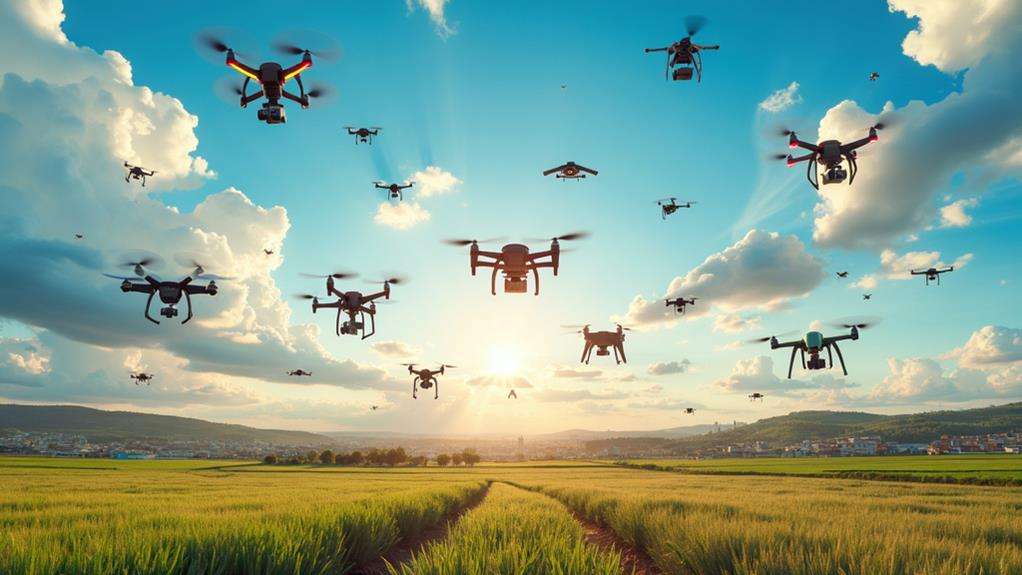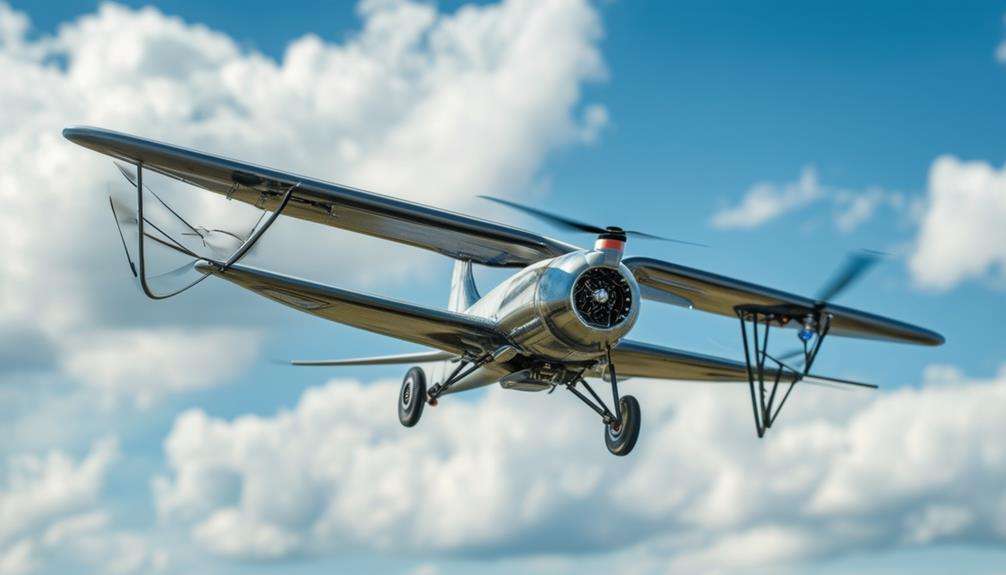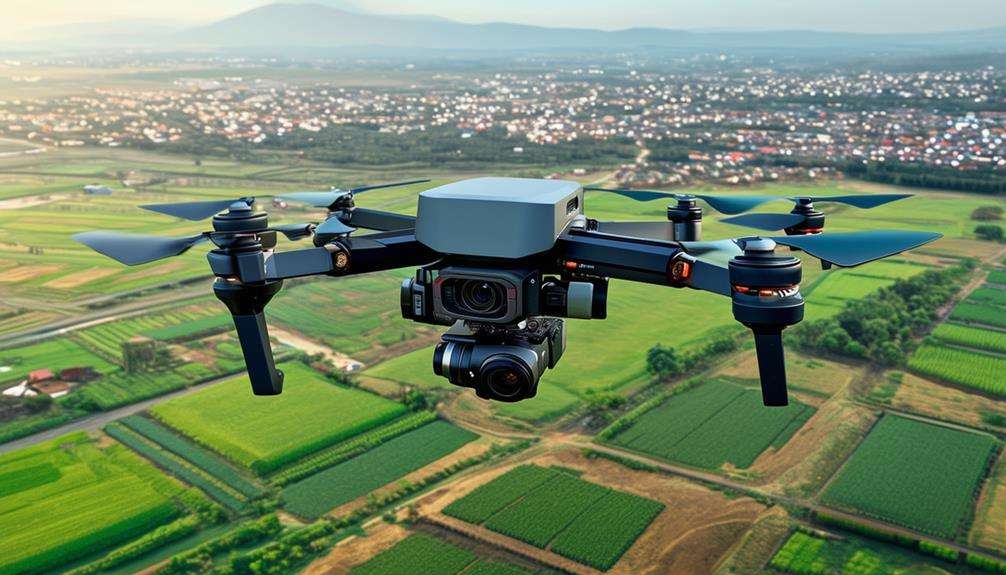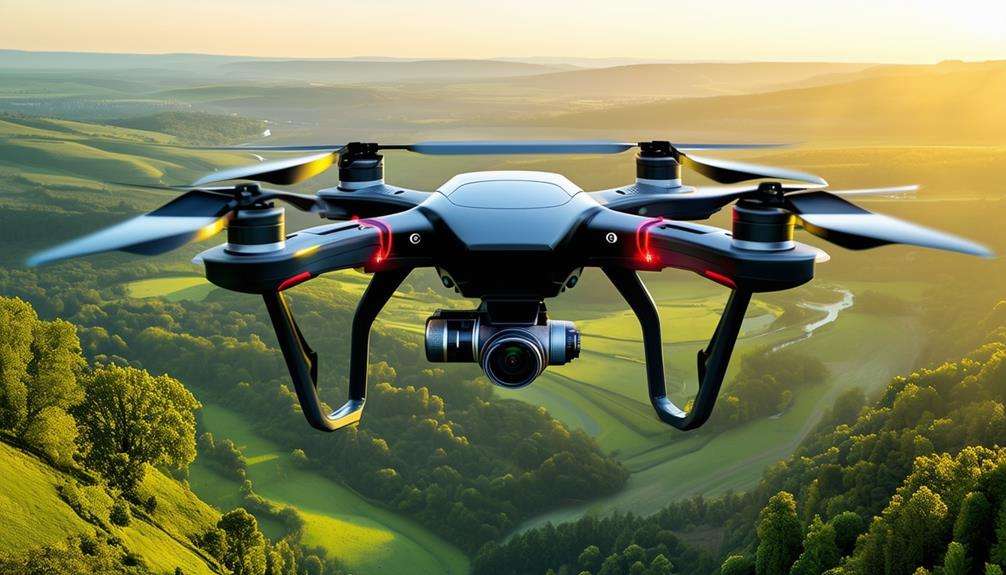The Evolution of Unmanned Aerial Vehicles: From Military to Civilian Use
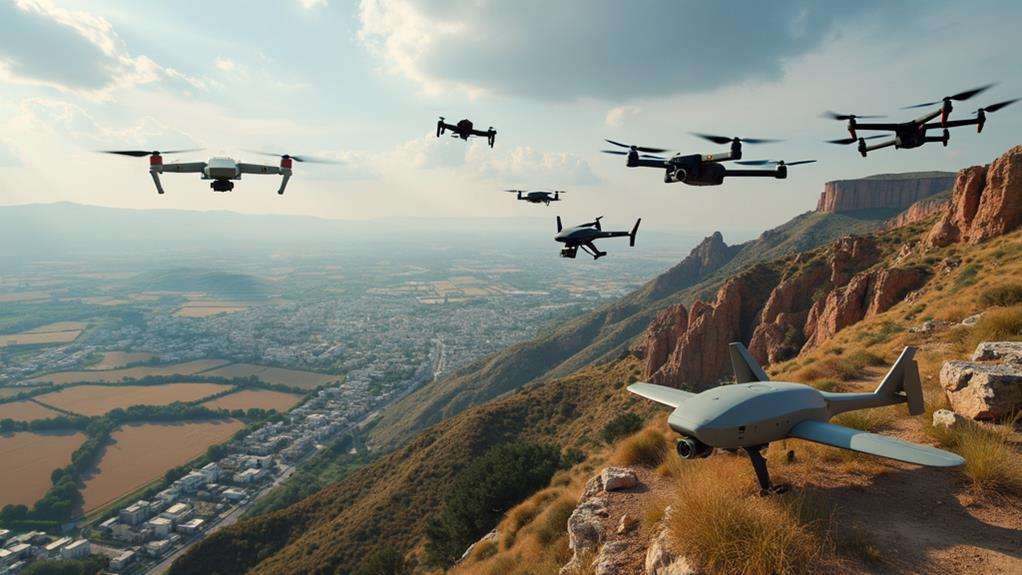
When you think of unmanned aerial vehicles (UAVs), military drones might come to mind, but their evolution extends far beyond that. Beginning with early prototypes like the Kettering Bug in World War I, UAVs have undergone significant transformation and now play vital roles in civilian sectors. These versatile machines are revolutionizing agriculture, enhancing emergency response, and reshaping various industries, challenging traditional methods. Interested in how UAV technology transitioned from military innovations to everyday applications? Let's explore this fascinating journey and discover what lies ahead for these airborne marvels.
Early Concepts and Prototypes
The concept of unmanned aerial vehicles (UAVs) began to take shape in the 19th century. In 1849, the Austrian military used incendiary balloons against Venice, introducing a primitive form of aerial combat. This event laid the groundwork for future UAV advancements.
During World War I, the British developed the Aerial Target in 1917, marking the creation of the first pilotless aircraft. In 1918, the Kettering Bug followed, representing another pioneering UAV prototype. Both innovations underscored the early potential of unmanned flight.
The 1930s saw the U.S. Navy adopting the term "drone" and utilizing radio control technology to develop target aircraft for military training. This period was crucial for refining UAV control mechanisms. During World War II, actor Reginald Denny designed the Radioplane OQ-2, the first mass-produced drone, with nearly 15,000 units manufactured for military training.
These early prototypes and advancements in radio control technology were foundational, highlighting the evolving role of UAVs in military strategy and paving the way for modern developments.
World War I and II Innovations
In exploring the innovations of World War I and II, it's evident that early military UAV prototypes like the Kettering Bug laid the groundwork, despite never being deployed in combat. The Radioplane OQ-2 and the Curtiss N2C-2 marked significant steps in aerial target development and remote control applications. WWII drone advancements peaked with the V-1 flying bomb, demonstrating the potential for offensive unmanned systems.
Early Military UAV Prototypes
The early military UAV prototypes from World War I and II catalyzed significant advancements in drone technology. During World War I, the Kettering Bug, developed in 1918, was designed as an early cruise missile. Although it had the capability to carry explosives over a distance, it was never used operationally. Around the same time, Britain tested the Hewitt-Sperry Automatic Airplane, considered the first flying bomb, marking a significant leap in drone technology.
In World War II, the term "drone" was coined by the U.S. Navy in 1936 to describe radio-controlled aerial targets. This led to the development of various target drones, including the widely produced Radioplane OQ-2, with nearly 15,000 units manufactured. Another notable development was the Curtiss N2C-2 drone, which could be remotely controlled from another aircraft, enhancing both training and operational capabilities.
These early prototypes laid the groundwork for future advancements in military UAVs, setting the stage for the sophisticated drones used today.
Aerial Target Development
Pioneering innovations in aerial target development during World War I and II revolutionized military training and operations. The origins of unmanned aerial vehicles (UAVs) can be traced back to World War I with the British Aerial Target, tested in March 1917. This marked the inception of unmanned flight aimed at improving military training. However, significant advancements occurred during World War II. The De Havilland DH.82B Queen Bee, introduced in 1936, established the term "drone" for radio-controlled aerial targets.
In World War II, actor Reginald Denny's Radioplane OQ-2 became the first mass-produced UAV, with nearly 15,000 units manufactured for target practice. These aerial targets were crucial in preparing gunners for actual combat situations. Additionally, the Kettering Bug, although never deployed in combat, was a significant precursor to modern drones, designed as an unmanned aerial torpedo.
Here is a timeline of key developments in aerial target technology:
| Year | Innovation |
|---|---|
| 1917 | British Aerial Target |
| 1918 | Kettering Bug |
| 1936 | De Havilland DH.82B Queen Bee |
| 1940 | Radioplane OQ-2 (by Reginald Denny) |
| 1942 | TD2D-1 Katydid |
These innovations laid the groundwork for the UAV technology we see today.
WWII Drone Advancements
World War II marked a pivotal era in the evolution of drone technology, significantly shaping military strategy and operations. One of the most notable advancements was the Radioplane OQ-2, the first mass-produced drone, with nearly 15,000 units manufactured for target practice and training. This innovation allowed soldiers to hone their skills on moving targets without risking lives, representing a significant leap in unmanned aerial vehicle (UAV) technology.
The U.S. Navy also made strides in this domain, experimenting with radio-controlled aircraft like the Curtiss N2C-2. Designed for remote operation from another aircraft, these early UAVs demonstrated the potential for advanced reconnaissance missions and other military applications.
The advancements in drone technology during WWII laid the groundwork for future developments. Key points include:
- Radioplane OQ-2: The first mass-produced drone primarily used for target practice.
- Curtiss N2C-2: An early example of remote-controlled UAV technology.
- Post-War Influence: The drone advancements from WWII had a lasting impact on military reconnaissance and the evolution of UAV technology.
These innovations established a foundation of trustworthiness and reliability, ensuring the ongoing relevance and interoperability of UAVs in modern military operations.
Cold War Advancements
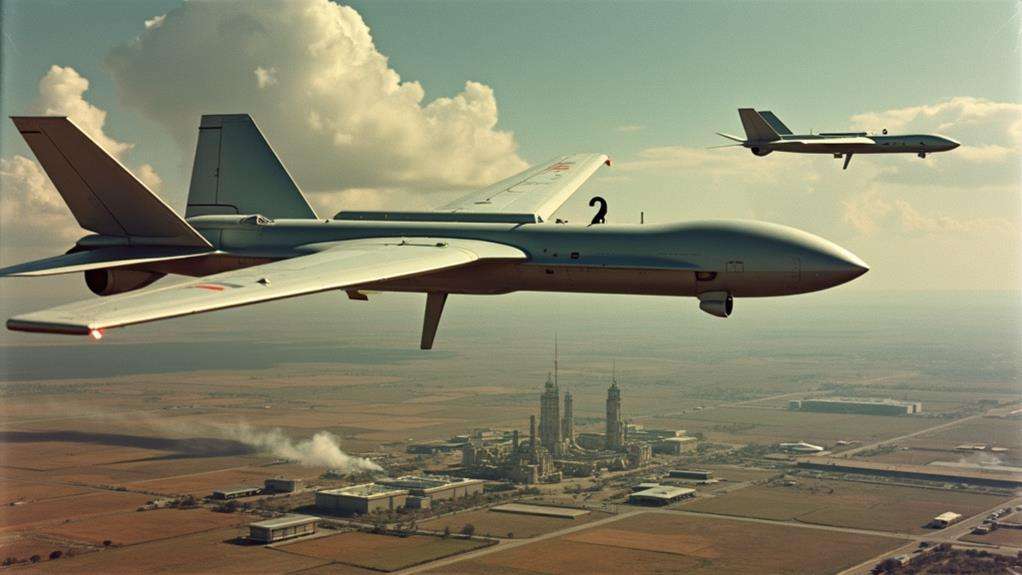
Amid the tense geopolitical climate of the Cold War, significant advancements in unmanned aerial vehicles (UAVs) revolutionized military capabilities. Early developments included piston-powered target drones like the MQM-33 Shelduck, which were pivotal for both military training and reconnaissance. The MQM-33 even executed the first battlefield unmanned aerial photo reconnaissance mission, underscoring its critical role in surveillance operations.
The Ryan Firebee platform emerged as a central asset for reconnaissance missions. During the Vietnam War, it provided invaluable aerial intelligence. Over 3,400 Ryan 147Bs (AQM-34s) were deployed, although 554 were lost, highlighting the growing reliance on UAVs for military use.
B-17 drones also played a vital role during this era. In 1946, they collected radioactive data during Operation Crossroads, showcasing the innovative application of UAVs in nuclear testing environments.
The Cold War period marked a transformative era for UAVs, blending technological advancements with strategic military applications. With each deployment, whether for reconnaissance during the Vietnam War or data collection in nuclear tests, UAVs like the Ryan Firebee and MQM-33 Shelduck proved indispensable. These developments set the stage for future advancements in both military and civilian UAV applications.
Transition to Civilian Use
The transition to civilian use of drones began significantly after the FAA authorized UAVs in U.S. civilian airspace in 2006. This move marked a pivotal shift from military to broader commercial and recreational applications. When drones were first used in civilian sectors, they quickly found roles in various industries, demonstrating their versatility and potential.
From 2006 onwards, the commercial drone market experienced substantial growth. By 2021, nearly 900,000 drones were registered in the United States, with projections indicating the market could exceed $12 billion. This surge reflects the growing investment in drones and their expanding utility. Notably, drones have become integral in:
- Aerial photography: Providing new perspectives and revolutionizing media production.
- Logistics: Companies like Amazon have pioneered drone deliveries, sparking interest in UAV-based delivery systems.
- Agricultural monitoring: Drones offer precise monitoring and data collection, significantly enhancing farming efficiency.
The FAA and EASA have played crucial roles in shaping regulatory frameworks, ensuring safe drone operations in civilian airspace. The transition to civilian use has unlocked numerous opportunities, driving innovation and investment across various sectors.
Agricultural Applications
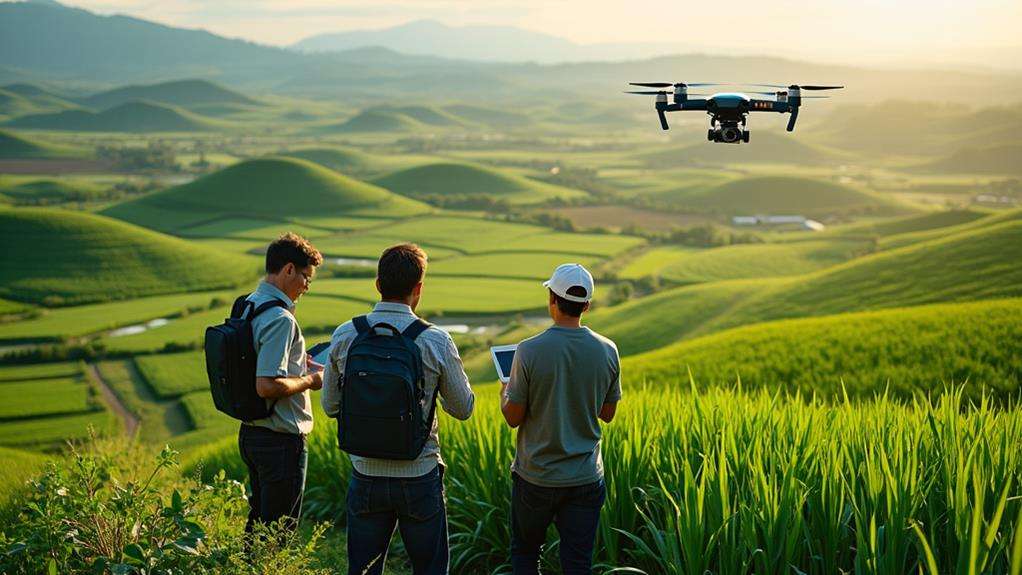
Drones are transforming precision agriculture by enabling efficient monitoring of crop health, soil conditions, and irrigation systems. Equipped with multispectral cameras, these drones can detect variations in plant health, allowing for targeted pest and disease control, thereby reducing pesticide use. By integrating this technology, farmers can significantly boost crop yields and streamline farm operations.
Precision Farming Techniques
Imagine a world where you can monitor your crops' health and optimize resource use without ever setting foot in the field. That's the power of drones in precision farming. With advanced aerial imagery and data analytics, crop monitoring has become more effective than ever. Drones equipped with multispectral and thermal cameras provide real-time assessments of crop conditions, enabling early detection of issues such as pests or nutrient deficiencies. This early detection can lead to yield increases of up to 20%.
The agricultural drone market is experiencing robust growth, projected to reach $1.4 billion by 2025, driven by the widespread adoption of precision agriculture practices. Drones can cover large areas quickly, mapping fields at a rate of 100 acres per hour, making crop monitoring far more efficient than traditional methods.
By integrating drones with AI and machine learning technologies, decision-making processes are significantly enhanced, allowing for:
- Targeted interventions to address specific crop issues.
- Reduced resource waste by up to 30%.
- Optimized inputs such as water, fertilizers, and pesticides.
This cutting-edge technology not only saves time but also maximizes agricultural efficiencies, making precision farming a transformative approach for modern agriculture.
Crop Health Monitoring
Leveraging advancements in precision farming, crop health monitoring through drones offers an innovative method to oversee plant conditions. UAVs equipped with multispectral cameras capture detailed images of crops, facilitating the assessment of plant health and identification of areas needing attention based on light reflectance at various wavelengths. This precision agriculture approach can increase crop yields by up to 20% through targeted interventions like variable rate irrigation and fertilization driven by real-time data.
Drones can swiftly cover extensive agricultural areas, with some models capable of mapping up to 100 acres per flight, significantly reducing the time required for field assessments. Additionally, pesticide use can be decreased by up to 90% as treatments are applied only where necessary, minimizing environmental impact and cutting costs. The agricultural drone market is expected to reach approximately $5.7 billion by 2026, highlighting the growing adoption of drone technology for crop health monitoring and management. By embracing these technological innovations, farming practices can become more efficient and sustainable.
Pest and Disease Control
Drones are transforming pest and disease control in agriculture by delivering unmatched efficiency and precision. Equipped with advanced aerial imaging technologies, UAVs enable you to identify and treat affected areas in your fields more effectively. This real-time data collection helps detect crop stress from pests or diseases before visible symptoms appear, allowing for timely interventions that can save your yields.
The use of multispectral imaging in drones offers several notable advantages:
- Reduced Pesticide Use: Research indicates that drone applications can reduce pesticide use by up to 30%, supporting more sustainable farming practices.
- Targeted Application: Drones enable precise pesticide application, minimizing chemical exposure to non-target species and reducing environmental impact.
- Enhanced Crop Health: Early detection and treatment of crop stress lead to healthier plants and improved overall crop productivity.
With the global agricultural drone market expected to reach $12 billion by 2027, adopting UAVs for pest control is a growing trend that offers significant benefits. The precision and efficiency of drone technology make it a valuable asset in sustainable agriculture, helping you maintain healthy crops while minimizing environmental harm.
Media and Entertainment
Drones have significantly transformed the media and entertainment sectors by enabling filmmakers and content creators to capture stunning, high-quality footage from previously inaccessible angles. This technology has revolutionized aerial photography and videography, adding a dynamic dimension to storytelling.
The FAA's Part 107 rule, established in 2016, provided clear regulations for the commercial use of drones, facilitating safer and more widespread adoption in the media and entertainment industries. This regulatory framework has enabled the use of drones in various applications, including live events, sports coverage, and cinematic productions.
Equipped with advanced cameras and stabilization technology, drones have become indispensable tools for aerial imaging. Major media companies and production houses have integrated drones into their workflows for a range of uses, from real estate photography to live broadcasting of major events. The global market for drone-based services is booming and is projected to reach $1.6 billion by 2025.
Here's a quick overview:
| Aspect | Details |
|---|---|
| Drone Technology | Advanced cameras, stabilization technology |
| FAA Regulations | Part 107 rule for commercial use |
| Market Projection | $1.6 billion by 2025 |
This concise yet comprehensive overview underscores the transformative impact of drones on the media and entertainment industries.
Search and Rescue Operations
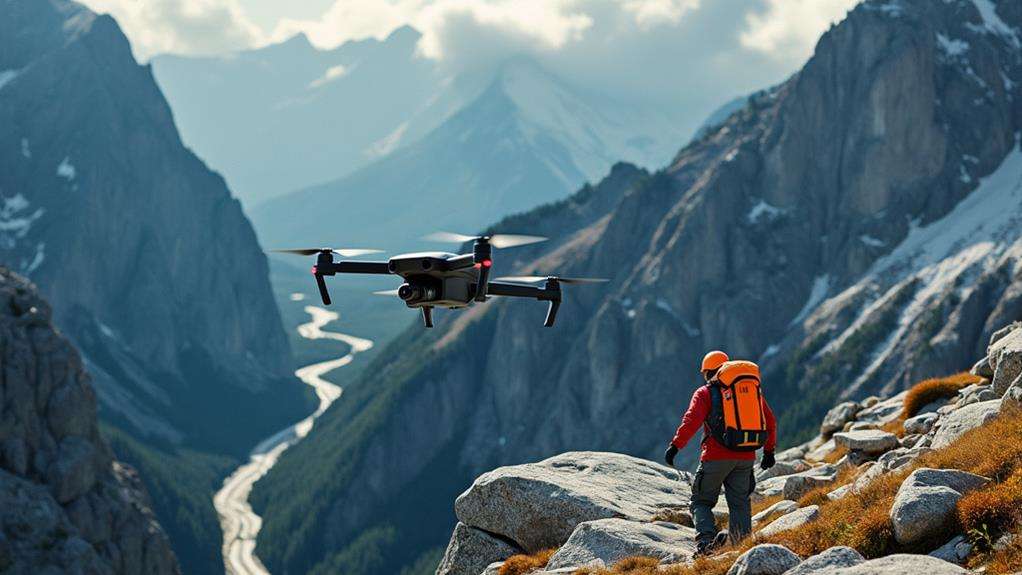
In search and rescue operations, the integration of drone technology has transformed the assessment of disaster areas and the location of victims. Drones can swiftly cover large, disaster-stricken regions, providing real-time aerial footage that facilitates locating missing persons and evaluating damage.
Equipped with thermal imaging and infrared cameras, drones excel in detecting heat signatures, invaluable in challenging environments like dense forests or chaotic disaster zones. For instance, in 2018, a drone in the UK located a missing hiker in just 15 minutes, demonstrating its potential to significantly reduce response times.
Numerous organizations are incorporating drone technology into their emergency response protocols, including:
- The Red Cross: Using drones for faster disaster relief and efficient resource allocation.
- Local fire departments: Leveraging real-time aerial footage to locate victims and assess fire damage more effectively.
- Training programs: Enhancing the effectiveness of drone-assisted operations by training responders in their use.
Environmental Monitoring
Unmanned aerial vehicles (UAVs) have emerged as essential tools in environmental monitoring due to their versatility and advanced capabilities. Drones offer high-resolution aerial imagery, enabling precise assessments of land use changes, deforestation, and habitat destruction. This detailed data collection aids in making informed decisions to protect natural resources.
In wildlife conservation, drones equipped with thermal imaging and GPS technology allow for tracking animal populations and monitoring illegal poaching with minimal disturbance. These capabilities are vital for safeguarding endangered species and preserving biodiversity.
In agriculture, drones significantly enhance precision farming through multispectral imaging, which analyzes crop health and optimizes resource usage. This not only boosts crop yields but also reduces environmental impact.
Moreover, drones facilitate air and water quality monitoring in remote or hard-to-access areas, quickly collecting data for timely environmental health and pollution assessments. As environmental awareness grows, the demand for these innovative solutions increases. The global market for environmental monitoring drones is projected to reach approximately $947.6 million by 2027, highlighting their crucial role in environmental stewardship.
Future Trends and Innovations
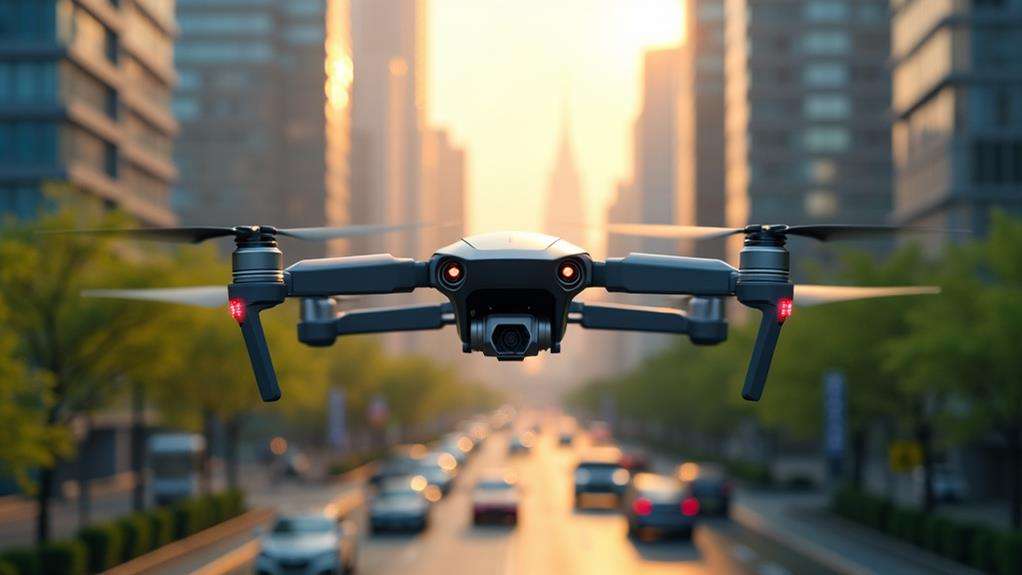
Imagine a future where drones autonomously navigate busy skies, delivering packages, inspecting infrastructure, and aiding in emergency responses seamlessly. That future isn't far off, thanks to exciting innovations and emerging trends in the UAV market. By 2030, the UAV market is projected to reach $92 billion, driven by diverse applications across various sectors.
Key future trends include:
- Autonomous drones: Enhanced navigation systems and AI-powered capabilities are making drones smarter and more efficient in complex environments.
- Drone delivery services: Pilot programs and partnerships, such as 7-Eleven's collaboration with Flirtey, demonstrate the potential for commercial drone deliveries to become mainstream.
- Critical infrastructure inspection: Companies like Percepto are advancing autonomous industrial drones for remote inspection and monitoring.
Regulatory frameworks are evolving, with the FAA's new type certification program streamlining approvals for autonomous drones. This facilitates their integration into industries like agriculture, infrastructure inspection, and emergency response.
As these innovations unfold, drones will become indispensable tools in daily life. They will not only transform package delivery but also enhance the safety and efficiency of monitoring critical infrastructure. With the evolution of regulations and technology, the future of UAVs is boundless.

